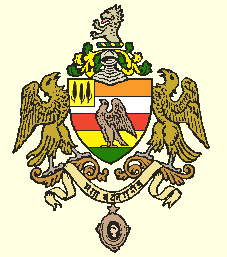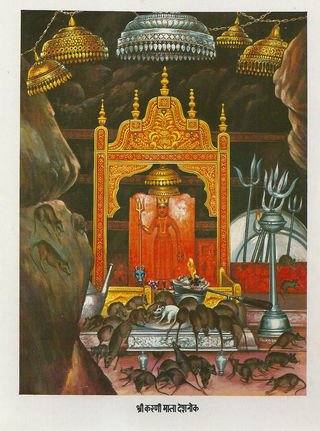
Rao Bika Rathore, was a scion of the Rathore clan of Rajputs and the founder of the city of Bikaner and Bikaner State in present-day state of Rajasthan in India. He was the fifth son of Rao Jodha, founder of the city of Jodhpur. During his reign he controlled an area of 40,000 square miles, which included 3,000 villages.

Marwar is a region of western Rajasthan state in North Western India. It lies partly in the Thar Desert. The word 'maru' is Sanskrit for desert. In Rajasthani languages, "wad" means a protected area. English translation of the word 'marwar' is the region protected by desert.

Hanumangarh is a city and municipal council in the Indian state of Rajasthan, situated on the banks of the river Ghaggar also identified as ancient Sarasvati river, located about 400 km from Delhi. It is the administrative headquarter of Hanumangarh District. The city was once called Bhatner because it was founded by king Bhupat in 255 AD. It remained in the control of the Rajputs of Bhati clan and faced a historic siege by Timur in 1391, during which the Bhati Raput king Dulachand lost the fort for a short time. The fort was later occupied by Rao Jetsa of Bikaner.

The Rathore dynasty or Rathor dynasty was an Indian dynasty belonging to the Rathore clan of Rajputs that has historically ruled over parts of Rajasthan, Gujarat and Madhya Pradesh.
In Haryana Johiya belong ot chippi caste under muslim religion. Mainly found in Jind district. Famous leader Abhishek johiya are also belong to this clan and area.

Rao Maldeo Rathore was a king of the Rathore dynasty, who ruled the kingdom of Marwar in present day state of Rajasthan. Maldeo ascended the throne in 1531 CE, inheriting a small ancestral principality of Rathore's but after a long period of military actions against his neighbours, Maldeo swept significant territories which included parts of present day Rajasthan, Haryana, Uttar Pradesh, Gujarat and Sindh. He refused to ally with either the Sur Empire or the Mughal Empire.

Rao JodhaRathore was the 15th Rajput chief of Rathore clan who ruled the Kingdom of Marwar in the present-day state of Rajasthan. He was the fifth son of Rao Ranmal. He is known for his illustrious military career and for founding the city of Jodhpur in 1459, which subsequently became the new capital of Marwar after Mandore.

Karni Mata, known by various names such as Bhagwati, Mehaai, Jagdamba, and Kiniyani is a Hindu Goddess of power and victory described as a warrior sage, who lived between 14th and 16th centuries in Western Rajasthan. Karni Mata is the tutelary deity of the Rajputs and Charans of northwestern India. As a Sagati, she is also worshipped as an incarnation of Hinglaj or Durga. She is the official deity of the royal families of Bikaner and Jodhpur. Karniji played an important role in shaping the history of the region. She is intimately associated with the establishment of the Rajput hegemony in the region. With her blessings, Rao Jodha and Rao Bika founded the kingdoms of Jodhpur and Bikaner. At the request of the Maharajas of Bikaner and Jodhpur, she laid the foundations of Bikaner Fort and Mehrangarh Fort, the two most important forts in the region. She lived an ascetic life and was widely revered during her lifetime. Indian Army troops from the Marwar region also regard Karni Mata as their patron deity.

The region of Bikaner, stretching across north-western state of Rajasthan in India, was earlier known as Jangladesh. It included the present-day districts of Bikaner, Churu, Ganganagar, and Hanumangarh. It is bounded on the south by Marwar and Jaisalmer regions, on the east by Ajmer-Merwara region.
Rania is a town and a municipal committee in Sirsa district located on the upper bank of Ghaggar River in the Indian state of Haryana. Rania Town is a grain market in Sirsa district. Nearby cities to Rania includes Sirsa and Ellenabad. It shares its RTO office with Ellenabad which is also has its headquarters in Ellenabad. Earlier it was a part of Ellenabad subdivision but later carved out separately as a subdivision in Sirsa district of Haryana. It is at a distance of 22 km each from Sirsa and Ellenabad in opposite direction on Haryana State Highway 32A i.e. Bhambhoor-Jiwan Nagar Road which connects to Haryana State Highway 32 in Jiwan Nagar on one end and Haryana State Highway 23 in Bhambhoor on the other end.

Sheikhsar is a village in Lunkaransar tehsil of Bikaner district in Rajasthan, India. It is situated on the north-east border of the district adjoining Churu and Hanumangarh district boundaries. The village has a population of 5820 out of them are Scheduled Caste(SC) 1182 and Scheduled Tribe(ST) 4.

Kingdom of Marwar, also known as the Jodhpur State under the British, was a kingdom in the Marwar region from 1243 to 1818 and a princely state under British rule from 1818 to 1947. It was established in Pali by Rao Siha, possibly a migrant Gahadavala noble, in 1243. His successors continued to struggle against regional powers for domination and 9 out of 15 rulers till 1438 died in combat. In 1395, its capital was changed to Mandore by Rao Chunda of Mandore and to Jodhpur in 1459 by Rao Jodha.
The Battle of Sammel, also known as the Battle of Giri-Sumel, took place in 1544. It was fought near the villages of Giri and Sumel, between the Afghan Sur Dynasty under Sher Shah Suri and the Rathore army led by the commanders Jaita and Kumpa of Rao Maldeo Rathore.

The Bhatner fort is at Hanumangarh in Rajasthan, India, about 419 km northwest of Jaipur along the old Multan-Delhi route and 230 km north-east of Bikaner. The old name of Hanumangarh was Bhatner, which means "fortress of the Bhati". Believed to be 1700 years old, it is considered to be one of the oldest forts of India.

Rawat Kandhal, the third son of Rao Ranmal, was the founder of the Kandhalot clan of the Rathore dynasty in Northern India, and the co-founder of the kingdoms of Bikaner and Marwar.
Rao Ranmal, also called Ran Mal or Ridmal, was the Rathore ruler of Marwar. A notable expansionist and skilled warrior, Ranmal is also noteworthy for having twice served as regent of the kingdom of Mewar under two different kings.
Bhatti is a Punjabi and a Sindhi caste of Rajputs and Jats. The name Bhatti is a Punjabi form of Bhati, and they along with Bhuttos and Bhatias claim to have originated from the Hindu Bhati Rajputs.

Malasar(हिंदी: मालासर) is a large village located in Bikaner District which is in the north-west of the state of Rajasthan, India. This village is the Panchayat headquarters of three nearby villages. There are a total of 450 houses in the village. This village is popular for its unique geographical location, beautiful sand dunes and sandy paths located in the heart of the Thar Desert.













